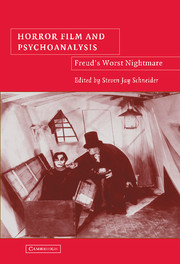Book contents
- Frontmatter
- Contents
- Acknowledgments
- Foreword: “What Lies Beneath?”
- Introduction: “Psychoanalysis in/and/of the Horror Film”
- PART ONE THE QUESTION OF HORROR-PLEASURE
- PART TWO THEORIZING THE UNCANNY
- 5 Explaining the Uncanny in The Double Life of Véronique
- 6 Manifestations of the Literary Double in Modern Horror Cinema
- 7 Heimlich Maneuvres: On a Certain Tendency of Horror and Speculative Cinema
- 8 “It was a dark and stormy night…”: Horror Films and the Problem of Irony
- PART THREE REPRESENTING PSYCHOANALYSIS
- PART FOUR NEW DIRECTIONS
- Afterword: Psychoanalysis and the Horror Film
- About the Contributors
- Bibliography
- Index
5 - Explaining the Uncanny in The Double Life of Véronique
Published online by Cambridge University Press: 14 July 2009
- Frontmatter
- Contents
- Acknowledgments
- Foreword: “What Lies Beneath?”
- Introduction: “Psychoanalysis in/and/of the Horror Film”
- PART ONE THE QUESTION OF HORROR-PLEASURE
- PART TWO THEORIZING THE UNCANNY
- 5 Explaining the Uncanny in The Double Life of Véronique
- 6 Manifestations of the Literary Double in Modern Horror Cinema
- 7 Heimlich Maneuvres: On a Certain Tendency of Horror and Speculative Cinema
- 8 “It was a dark and stormy night…”: Horror Films and the Problem of Irony
- PART THREE REPRESENTING PSYCHOANALYSIS
- PART FOUR NEW DIRECTIONS
- Afterword: Psychoanalysis and the Horror Film
- About the Contributors
- Bibliography
- Index
Summary
It is only rarely that a psycho-analyst feels impelled to investigate the subject of aesthetics … But it does occasionally happen that he has to interest himself in some particular province of that subject; and this province usually proves to be a rather remote one, and one which has been neglected in the specialist literature of aesthetics. The subject of the “uncanny” is a province of this kind.
– Sigmund FreudKrzysztof Kieslowski's 1991 film The Double Life of Véronique (La Double Vie de Véronique, hereafter DLV) is a gently tragic tale whose eerie tone merits the label “uncanny.” Premised on the assumption that life itself may be uncanny, DLV tells the tale of two women in France and Poland who are somehow doubles – and who feel this about themselves. (Both are played by Irène Jacob, who won Best Actress at Cannes for her performance.) This premise is made plausible through a rich cinematic style, comparable to the paintings of Vermeer (we often see a woman standing in a room illuminated with side lighting from a window) and Rembrandt (the movie was shot with a filter that provided a golden tone).
Through strikingly composed sequences, DLV insists that unsettling structures of fate are at work in both art and life. For example, the Polish Veronika is singing an ethereal musical phrase on stage when she collapses from a weak heart and dies.
- Type
- Chapter
- Information
- Horror Film and PsychoanalysisFreud's Worst Nightmare, pp. 87 - 105Publisher: Cambridge University PressPrint publication year: 2004
- 2
- Cited by



